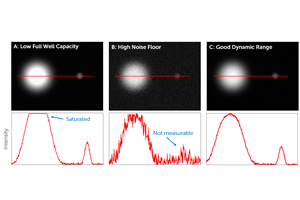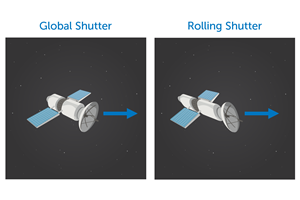Introduction
In Scientific Imaging, we are met with unique challenges. Signals from our imaging subject can often be very weak. With the move to CMOS technology, Quantum Efficiency, Read Noise and Dynamic Range are all optimized to work with weak signals. Once these factors are optimal, the only variable available to us to increase our collection of signal from the subject is to expose our image to light (integrate) for longer. Through longer exposure times, from tens of seconds to multiple minutes, the aim is that enough photons will be collected to provide an adequate signal to noise ratio for a high-quality image, measurement, or analysis.
However, signal is not the only thing that can increase with longer exposures. There are three main factors working against longer exposure time imaging. Firstly thermal ‘Dark Current’ signal and its accompanying noise contribution. Second, individual ‘hot pixels’ with dark current much higher than the average. And finally, for back-illuminated (high quantum efficiency) CMOS devices a common issue is sensor glow, where regions of the sensor close to on-sensor electronics experience higher dark background signals.
All of these factors can be managed by cooling camera sensors, enabling higher quality, lower noise imaging over long exposures. But for large sensor area devices, cooling is a far larger engineering challenge. Deep-cooled sensors also must be kept free of condensation – methods used by many manufacturers don’t offer maintenance-free, high-longevity solutions to this problem. However, with Teledyne’s LACera technology, all of this is changing.
In this technical note, the origin and effect of these challenges will be explored. Then, the unique capabilities of LACera technology for high-performance, maintenance-free CMOS cooling will be explored.
Challenges of Long Exposure Imaging
Dark Current
Camera sensors detect light through capturing incident photons and releasing photoelectrons, through the photoelectric effect. The number of detected photoelectrons in each pixel at the end of the exposure makes up our image. However, incident photons are not the only source of electrons within the pixel. Some electrons within the silicon and the components of the pixel can free themselves through thermal motion and enter the pixel well. There is no way within the pixel to differentiate between photoelectrons, and these ‘noise’ electrons.
This thermal release of electrons occurs randomly, though typically with a well-defined average rate that can differ across the sensor. The net effect is a gradual increase in the ‘dark counts’, the measured signal with no incident photons, for increasing exposure time.
The dark counts (in units of electrons) in a pixel is given by:
Dark Signal (e-) = Dark Current (e- / pixel / second) × Exposure Time (seconds)
Why can’t this increased background count simply be subtracted from the image post-acquisition? In reality, performing this subtraction can be helpful, but the real cost of dark current is not the counts but in dark current noise. Due to the random timing of thermal electron capture, the total electrons captured is random and follows Poisson statistics; random events with a known average. Like all Poisson behaviors, the uncertainty in the count (the noise contribution) is the square root of the counted events:
Dark Current Noise (e–) = √Dark Signal (e–)
The solution to dark current is cooling. However, different sensors and sensor technologies respond to cooling to different extents. For CMOS cameras, there is typically an optimum cooling value below which little further performance benefit is achieved.
Typical dark current values for conventionally cooled, back-illuminated CMOS cameras might be on the order of 2e-/pixel/second (e-/p/s), and for uncooled CMOS can be as high as 50e-/p/s. For a 60 second exposure, 2e-/p/s result in a noise contribution of √(
Hot Pixels
The distribution of dark current across a sensor will never be completely uniform – some pixels may, due to local defects in the silicon, exhibit several times the dark current of their neighbors. These are called ‘hot pixels’. They represent a challenge to image quality and image display scaling. The solution is that the occurrence of hot pixels, like dark current, is much reduced by sensor cooling.
Why is cooling challenging on large sensors?
Cooling Without Condensation
When air encounters a cold surface, condensation will form. Camera sensors are frequently thermo-electrically cooled to sub-zero temperatures. So how is condensation prevented from forming on sensitive components such as the sensor surface?
Cooled camera sensors are isolated from the surrounding atmosphere inside purpose-built chambers to provide both thermal insulation from the surrounding atmosphere and protection from condensation. The method of this isolation varies between camera manufacturers.
One common method is so-called ‘back-filling’, where an airtight chamber is formed around the sensor filled with an inert gas such as argon. This method is reliable and cost-effective, providing long potential camera lifetimes. However, there are downsides to this approach. Firstly, there will be some convective heat transfer from the sensor to the chamber walls, meaning that the thermal performance will not be as powerful in removing heat from the sensor. Further, the seals used cannot be perfect, and over a number of years condensation will eventually get in. This is typically expected to take as long or longer as the service lifetime of the camera – backfilled chambers lasting a decade are not uncommon.
An alternative is to produce a vacuum in the sensor chamber. This vastly reduces the convective heat transfer within the chamber, so permits better thermal management of the sensor. However, there are different methods to contain the vacuum with very different reliability and longevity against condensation. One method used by many manufacturers is to use a chamber where the sensor window, the glass covering the front of the chamber where light comes in, is affixed to the rest of the chamber with specialist epoxy. While this is the more cost-effective vacuum sealing method, the reliability of the seal formed could be considered worse than even the back-filled case discussed above, with seal lifetimes being more variable. What’s more, epoxy seals are not hermetic, meaning quantities of air and moisture will be slowly permeating through the seal. This means such vacuum chambers require maintenance and have much reduced service lifetime.
The solution to these issues is to use an all-metal hermetic sealed vacuum chamber, as is found in LACera Technology cameras. Although this requires more engineering, the result is a permanent seal that does not suffer from air or condensation ingress, offers true maintenance-free operation and the longest service lifetimes, and allows the best thermal performance.
Large Sensors, Fast Framerates, Lots of Heat
Another challenge relates specifically to large sensor CMOS cameras. CMOS provides versatility with both high speed readout for fast framerates or decision-making, and the low noise and high sensitivity required for weak signals with longer exposures. LACera Technology sensors are capable of producing more high quality data at high speed than ever before. But with higher pixel counts and faster frame rates comes more heat produced by the sensor electronics. The required power dissipation therefore increases significantly with sensor size and speed. This increases the challenge of reaching sub-zero sensor temperatures to provide ultimate versatility and performance.
Cooling the Uncooled
Most scientific CMOS sensors are not designed to be cooled. The majority of the applications for most off-the-shelf CMOS sensors are for lower-cost, higher-volume industrial applications requiring little or no sensor cooling. Hence, less beneficial cooling performance is achieved when applying cooling as an afterthought to CMOS sensors. Sensors that are built for cooling are accessible through custom sensor design, but for most manufacturers, this is out of reach.
World-class cooling performance with lifetime vacuum guarantee: how LACera technology takes CMOS to the next level
With LACera Technology, Teledyne is pulling together expertise and proprietary technology at every stage of the manufacturing process. From pixel design, sensor fabrication and camera manufacture to data handling and software, all aspects of LACera Technology products are designed and manufactured in-house. This provides us with a unique opportunity to bring together the strengths across Teledyne. With the combination of an in-house designed sensor, customized for deep cooling, and the decades of world-leading innovation in cooling and housing design from Teledyne Princeton Instruments, the cooling performance of LACera Technology overcomes even the demands of these large, high framerate sensors.
Using an all-metal hermetic seal with lifetime vacuum guarantee provides LACera Technology sensors with ultimate reliability and cooling performance. Reaching sensor temperatures of -30°C provides LACera Technology sensors with dark current values on the order of 0.05e-/p/s, which combined with the world-leading 0.7e- read noise, provides unbeatable noise performance for exposure times ranging from seconds to minutes.
When exposure times of 10s of minutes to hours are required
For exposure times of over 10 minutes, the dark current performance of CCD-based sensors is still unbeaten. The same all-metal hermetic seal vacuum technology and cooling performance is leveraged by Teledyne Princeton Instruments in their world-leading range of large-array CCD sensors. For more information, and to discover which camera technology suits your application, please contact Teledyne Princeton Instruments via our website or your local representative.



